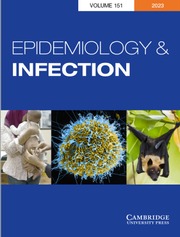Article contents
Prevalence of Helicobacter pylori infection in a cohort of Italian military students
Published online by Cambridge University Press: 01 March 1998
Abstract
In 1990, to study regional prevalences and risk factors of Helicobacter pylori infection in healthy young adult males, sera were collected from a nationwide sample of 1659 males (mean age 20·7 years) at introduction into the Air Force School for military students in Caserta, Italy. An enzyme-linked immunosorbent assay was used to detect H. pylori specific immunoglobulin G antibodies. The observed overall seropositivity rate was 17·5% (95% CI 15·7–19·4). Prevalence was higher in southern Italy and in the Italian islands as compared with northern Italy and central Italy (21·3% vs. 9·5%). Multiple logistic regression analysis showed that residence in southern areas and islands was the strongest predictor of the likelihood of H. pylori seropositivity; number of siblings in the household was marginally associated; years of father's schooling was not a significant predictor. H. pylori positive subjects were more likely positive for antibodies to hepatitis A virus infection (anti-HAV) than those H. pylori negative (35·4% vs. 24·9%; Odds Ratio 1·7, 95% CI 1·3–2·2). Adjustment for the confounding effect of sociodemographic variables weakened this association (OR 1·3, 95% CI 1·0–1·7). These findings suggest that differences in environmental conditions rather than in socioeconomic status may have played the major role in the different spread of H. pylori infection across the country.
- Type
- Research Article
- Information
- Copyright
- 1998 Cambridge University Press
- 10
- Cited by


